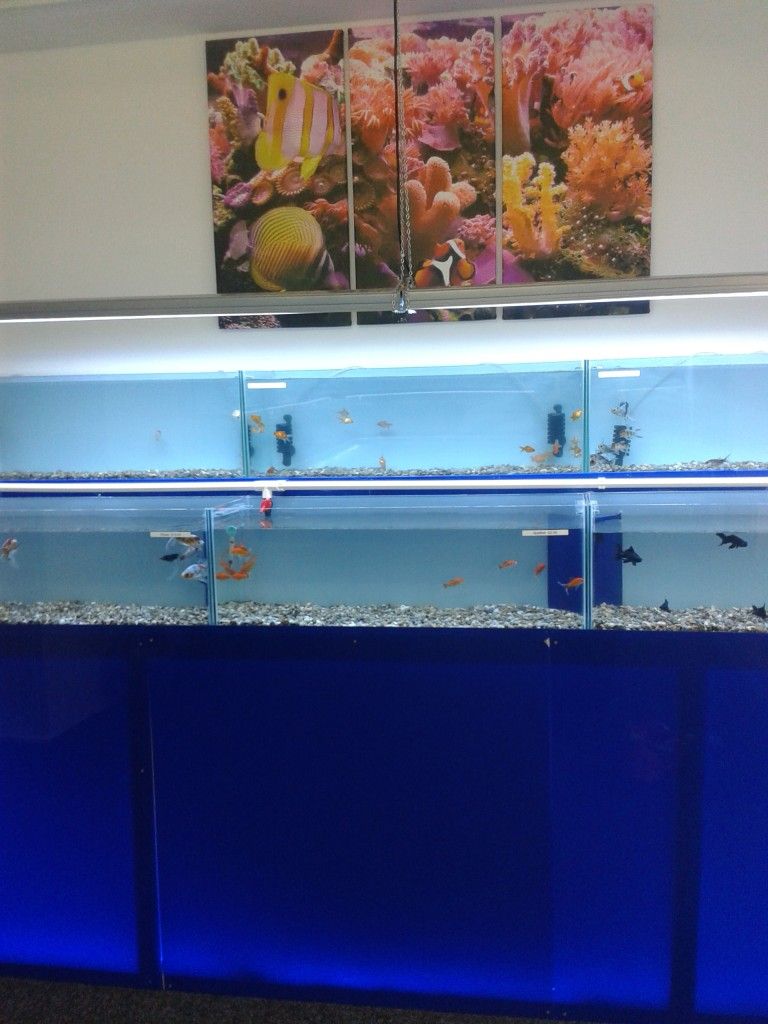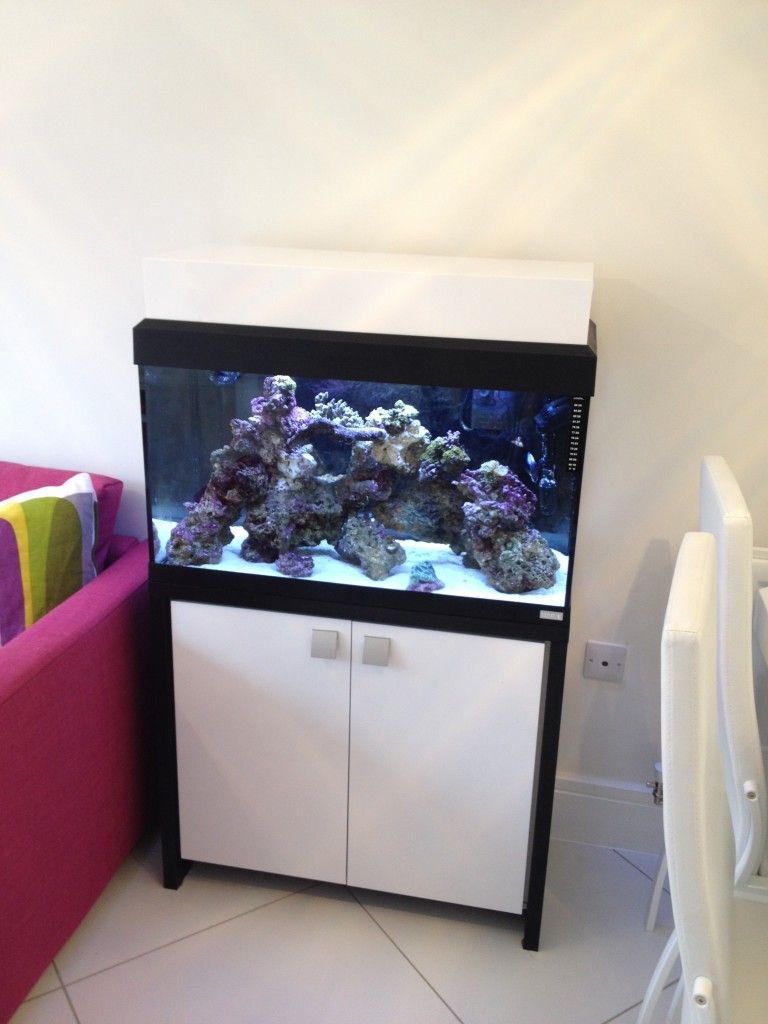The ideal material for Aquariums and fish tanks, acrylic is sturdy, durable, waterproof, and has the same crystal clear transparency as glass so that you can watch your fish as they go about their day. Even more importantly, sheets of acrylic can be bonded together through various methods, and once they have been, the area where the two sheets joined will be practically seamless, meaning no potential leaks.Using acrylic to build aquariums and fish tanks is easy once you have the right tools and the know-how. You can cut sheets of acrylic to size yourself or if you’d prefer you can order cut to size acrylic sheets direct from Cut Plastic Sheeting; all you need to do is send us the dimensions you desire. Depending on your level of ability, the tools you have and how daring you want to be you can make your fish tank as a simple box, complete with right angles, or you can round off the edges to make it more decorative. We will only be covering how to do the former, as the tools and expertise required to achieve the latter are quite advanced.Step One – DimensionsThe first thing you need to do is decide how big you want your aquarium to be. You should consider the size of the fish you intend to fill it with, their number, and how large the room you want the tank installed in is. You may also want to look into the cost of a filtration system for larger tanks, if you’re thinking about going big.Step Two – Cutting AcrylicAssuming you have decided to cut your acrylic sheets to size yourself, you will need to clearly mark out where you are going to cut. Always leave the protective film that the sheets are delivered with on until the latest moment possible and do your markings directly onto it with a marker. If for what ever reason it is not on, use masking tape to show the cutting lines.If you are unsure how to cut acrylic properly, please see our user’s guide on ‘How To Machine Acrylic’.Step Three – Smooth the EdgesWhen you’re about to adhere two acrylic sheets together you must make sure that the conditions are perfect. Any two edges that will be bonded together will have to be flat and smooth, but most importantly they must be exactly the same size. Using a sanding block, sand the edges down starting with 120 grit paper and moving steadily up to 400 grit. Just to reiterate, you cannot marry two sheets together if either have rounded edges, so make sure they are flat.
Depending on your level of ability, the tools you have and how daring you want to be you can make your fish tank as a simple box, complete with right angles, or you can round off the edges to make it more decorative. We will only be covering how to do the former, as the tools and expertise required to achieve the latter are quite advanced.Step One – DimensionsThe first thing you need to do is decide how big you want your aquarium to be. You should consider the size of the fish you intend to fill it with, their number, and how large the room you want the tank installed in is. You may also want to look into the cost of a filtration system for larger tanks, if you’re thinking about going big.Step Two – Cutting AcrylicAssuming you have decided to cut your acrylic sheets to size yourself, you will need to clearly mark out where you are going to cut. Always leave the protective film that the sheets are delivered with on until the latest moment possible and do your markings directly onto it with a marker. If for what ever reason it is not on, use masking tape to show the cutting lines.If you are unsure how to cut acrylic properly, please see our user’s guide on ‘How To Machine Acrylic’.Step Three – Smooth the EdgesWhen you’re about to adhere two acrylic sheets together you must make sure that the conditions are perfect. Any two edges that will be bonded together will have to be flat and smooth, but most importantly they must be exactly the same size. Using a sanding block, sand the edges down starting with 120 grit paper and moving steadily up to 400 grit. Just to reiterate, you cannot marry two sheets together if either have rounded edges, so make sure they are flat. Step Four – Using Acrylic Cement
There are several ways to bond two acrylic sheets together, but when using acrylic to build aquariums or fish tanks we’d recommend using a method known as ‘Capillary Cementing’. You will need to ensure that both sheets slot together exactly, or else you will run the risk of the bond not forming properly.
Step Four – Using Acrylic Cement
There are several ways to bond two acrylic sheets together, but when using acrylic to build aquariums or fish tanks we’d recommend using a method known as ‘Capillary Cementing’. You will need to ensure that both sheets slot together exactly, or else you will run the risk of the bond not forming properly.
Acrylic Aquariums & Plastic Fish Tanks
 Depending on your level of ability, the tools you have and how daring you want to be you can make your fish tank as a simple box, complete with right angles, or you can round off the edges to make it more decorative. We will only be covering how to do the former, as the tools and expertise required to achieve the latter are quite advanced.Step One – DimensionsThe first thing you need to do is decide how big you want your aquarium to be. You should consider the size of the fish you intend to fill it with, their number, and how large the room you want the tank installed in is. You may also want to look into the cost of a filtration system for larger tanks, if you’re thinking about going big.Step Two – Cutting AcrylicAssuming you have decided to cut your acrylic sheets to size yourself, you will need to clearly mark out where you are going to cut. Always leave the protective film that the sheets are delivered with on until the latest moment possible and do your markings directly onto it with a marker. If for what ever reason it is not on, use masking tape to show the cutting lines.If you are unsure how to cut acrylic properly, please see our user’s guide on ‘How To Machine Acrylic’.Step Three – Smooth the EdgesWhen you’re about to adhere two acrylic sheets together you must make sure that the conditions are perfect. Any two edges that will be bonded together will have to be flat and smooth, but most importantly they must be exactly the same size. Using a sanding block, sand the edges down starting with 120 grit paper and moving steadily up to 400 grit. Just to reiterate, you cannot marry two sheets together if either have rounded edges, so make sure they are flat.
Depending on your level of ability, the tools you have and how daring you want to be you can make your fish tank as a simple box, complete with right angles, or you can round off the edges to make it more decorative. We will only be covering how to do the former, as the tools and expertise required to achieve the latter are quite advanced.Step One – DimensionsThe first thing you need to do is decide how big you want your aquarium to be. You should consider the size of the fish you intend to fill it with, their number, and how large the room you want the tank installed in is. You may also want to look into the cost of a filtration system for larger tanks, if you’re thinking about going big.Step Two – Cutting AcrylicAssuming you have decided to cut your acrylic sheets to size yourself, you will need to clearly mark out where you are going to cut. Always leave the protective film that the sheets are delivered with on until the latest moment possible and do your markings directly onto it with a marker. If for what ever reason it is not on, use masking tape to show the cutting lines.If you are unsure how to cut acrylic properly, please see our user’s guide on ‘How To Machine Acrylic’.Step Three – Smooth the EdgesWhen you’re about to adhere two acrylic sheets together you must make sure that the conditions are perfect. Any two edges that will be bonded together will have to be flat and smooth, but most importantly they must be exactly the same size. Using a sanding block, sand the edges down starting with 120 grit paper and moving steadily up to 400 grit. Just to reiterate, you cannot marry two sheets together if either have rounded edges, so make sure they are flat. Step Four – Using Acrylic Cement
There are several ways to bond two acrylic sheets together, but when using acrylic to build aquariums or fish tanks we’d recommend using a method known as ‘Capillary Cementing’. You will need to ensure that both sheets slot together exactly, or else you will run the risk of the bond not forming properly.
Step Four – Using Acrylic Cement
There are several ways to bond two acrylic sheets together, but when using acrylic to build aquariums or fish tanks we’d recommend using a method known as ‘Capillary Cementing’. You will need to ensure that both sheets slot together exactly, or else you will run the risk of the bond not forming properly.- When joining two sheets side by side, use an applicator with a narrow nozzle to apply acrylic cement on both of the edges and hold them tightly together with clamp
- When you’re bonding two sheets together to create a right angle, apply the cement along the inside length of the joint and clamp the sheets together firmly.
For more information on Acrylic, Perspex, MDF, Dibond and Polycarbonate please visit our Guide and Blog sections of the website.
Cut Plastic Sheeting are based on the south Coast in Ivybridge, Devon UK. We have a full manufacturing facility which enables us to offer Cut To Size Acrylic as well as Cut To Size MDF. Shop our full range of products, including our Clear Acrylic, coloured acrylic and more recent MDF Wood Sheet ranges.
Our Team are always here to help with any enquiry, please send us an email or for more urgent needs give us a call – Contact Us



